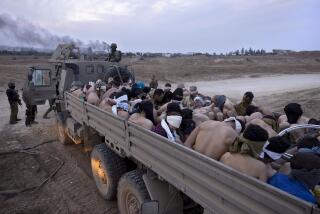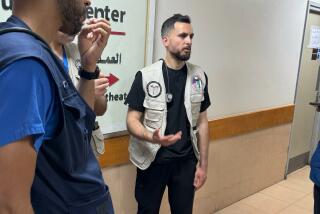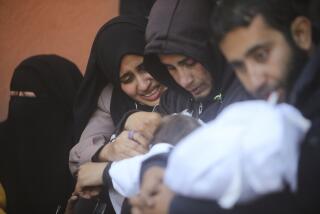U.S. hospital in Germany handles America’s Afghan war wounded
- Share via
Reporting from Landstuhl, Germany — Before Marine Cpl. Corey Griggs went on his last patrol in Afghanistan’s restive Helmand province, he had a premonition of sorts.
“I was joking with my buddies that it was going to be a bad night,” said Griggs, 23, of Portland, Ore.
He was right.
As darkness settled on a recent Saturday over the desert village of Sangin, someone threw a bomb over a mud wall at Griggs and his squad. The blast shattered his right forearm and embedded jagged shrapnel in his left.
After emergency surgery at a military outpost, Griggs, who is also being monitored for possible brain injuries, was placed aboard a specially outfitted cargo plane airlifting him to the Landstuhl Regional Medical Center next to the U.S. air base at Ramstein, Germany.
Since 2004, nearly 13,000 U.S. service personnel wounded in Afghanistan and Iraq have been evacuated to Landstuhl, the largest American-run medical facility outside the U.S.
Some of the wounded are patched up and sent back to frontline duty. Many others are taken to the U.S. for advanced treatment at military hospitals in Washington, D.C.; Bethesda, Md.; San Antonio; or San Diego.
As the U.S. troop buildup in Afghanistan continues, Landstuhl is experiencing an increase in wounded patients to levels unseen since the 2004 battles in the Iraqi city of Fallouja.
The complexity and severity of wounds are also increasing, said Army Col. John M. Cho, a chest surgeon who is the hospital’s commander. On a medical rating scale, the number of patients above a level considered extremely critical has increased 190% in the last two months, he said.
On the day Griggs arrived, the hospital was caring for patients wounded by gunfire, roadside bombs and rocket-propelled grenades, including a Marine with shrapnel in his back and bowels, and other troops with concussions, back injuries and a crushed hand.
On some occasions, a wounded soldier or Marine on life support will be brought to Landstuhl. Life is sustained long enough for family members to arrive from the U.S.
Navy Cmdr. Joseph Sheldon, one of nine chaplains at the hospital, meets them and guides them through the emotional process of saying farewell. It is not uncommon, he said, for them to ask the unanswerable question: How could a merciful God have let this happen?
“I tell them truthfully that I don’t know the answer,” said Sheldon, who deployed with the Marines during the assault on Baghdad in 2003. “I just know that I continue to believe God is good because I see so much of his goodness.”
With 3,000-plus employees and an annual budget of $180 million, Landstuhl provides care primarily for 245,000 U.S. military personnel and family members based in Europe and Africa.
More than 64,000 military personnel have been brought to Landstuhl from Iraq and Afghanistan since 2004, most for noncombat injuries or illnesses.
Griggs, assigned to the Twentynine Palms-based 3rd Battalion, 7th Marine Regiment, will leave soon to be reunited with his pregnant wife and their 2-year-old son. The Iraq veteran hopes to become a welder when his service ends soon.
Initial screening did not show any sign of traumatic brain injury, the so-called signature wound of the Iraq and Afghanistan wars. But medical specialists have found that such signs often show up months after an incident. For that reason, Griggs’ medical chart will call for periodic follow-up exams once he returns home.
For many here, the first thought is to return to duty.
Lance Cpl. Demon Bowles, 23, of Leavenworth, Kan., was brought to Landstuhl after he blacked out and banged his head while deployed in the sweltering Helmand heat.
A battery of tests has not uncovered a cause. Follow-up exams will be done by Navy doctors after he returns to base at Delaram in the southern Afghan province of Nimruz.
“I just want to get back to my unit,” Bowles said.
tony.perry@latimes.com
More to Read
Sign up for Essential California
The most important California stories and recommendations in your inbox every morning.
You may occasionally receive promotional content from the Los Angeles Times.










